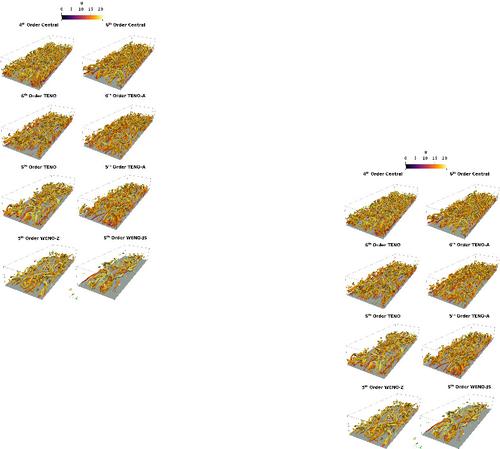当前位置:
X-MOL 学术
›
Int. J. Numer. Methods Fluids
›
论文详情
Our official English website, www.x-mol.net, welcomes your
feedback! (Note: you will need to create a separate account there.)
On the performance of WENO / TENO schemes to resolve turbulence in DNS / LES of high‐speed compressible flows
International Journal for Numerical Methods in Fluids ( IF 1.7 ) Pub Date : 2020-08-07 , DOI: 10.1002/fld.4879 Arash Hamzehloo 1 , David J. Lusher 2 , Sylvain Laizet 1 , Neil D. Sandham 2
International Journal for Numerical Methods in Fluids ( IF 1.7 ) Pub Date : 2020-08-07 , DOI: 10.1002/fld.4879 Arash Hamzehloo 1 , David J. Lusher 2 , Sylvain Laizet 1 , Neil D. Sandham 2
Affiliation

|
High-speed compressible turbulent flows typically contain discontinuities and have been widely modelled using Weighted Essentially Non-Oscillatory (WENO) schemes due to their high-order accuracy and sharp shock capturing capability. However, such schemes may damp the small scales of turbulence, and result in inaccurate solutions in the context of turbulence-resolving simulations. In this connection, the recently-developed Targeted Essentially Non-Oscillatory (TENO) schemes, including adaptive variants, may offer significant improvements. The present study aims to quantify the potential of these new schemes for a fully-turbulent supersonic flow. Specifically, DNS of a compressible turbulent channel flow with M = 1.5 and Reτ = 222 is conducted using OpenSBLI, a high-order finite difference CFD framework. This flow configuration is chosen to decouple the effect of flow discontinuities and turbulence and focus on the capability of the aforementioned high-order schemes to resolve turbulent structures. The effect of the spatial resolution in different directions and coarse grid implicit LES are also evaluated against the WALE LES model. The TENO schemes are found to exhibit significant performance improvements over the WENO schemes in terms of the accuracy of the statistics and the resolution of the three-dimensional vortical structures. The 6 order adaptive TENO scheme is found to produce comparable results to those obtained with non-dissipative 4 and 6 order central schemes and reference data obtained with spectral methods. Although the most computationally expensive scheme, it is shown that this adaptive scheme can produce satisfactory results if used as an implicit LES model. TENO; High-order; Channel flow; OpenSBLI; Code generation; GPU
中文翻译:

关于 WENO/TENO 方案解决高速可压缩流 DNS/LES 湍流的性能
高速可压缩湍流通常包含不连续性,并且由于其高阶精度和尖锐的冲击捕获能力,已使用加权基本非振荡 (WENO) 方案广泛建模。然而,这样的方案可能会抑制湍流的小尺度,并在湍流解析模拟的背景下导致不准确的解决方案。在这方面,最近开发的靶向基本非振荡 (TENO) 方案,包括自适应变体,可能会提供显着的改进。本研究旨在量化这些新方案对全湍流超音速流动的潜力。具体而言,M = 1.5 和 Reτ = 222 的可压缩湍流通道流的 DNS 使用 OpenSBLI(一种高阶有限差分 CFD 框架)进行。选择这种流动配置以消除流动不连续性和湍流的影响,并专注于上述高阶方案解决湍流结构的能力。还针对 WALE LES 模型评估了不同方向的空间分辨率和粗网格隐式 LES 的影响。发现 TENO 方案在统计的准确性和三维涡旋结构的分辨率方面比 WENO 方案表现出显着的性能改进。发现 6 阶自适应 TENO 方案产生的结果与使用非耗散 4 阶和 6 阶中心方案获得的结果以及使用光谱方法获得的参考数据相当。虽然是计算成本最高的方案,结果表明,如果用作隐式 LES 模型,这种自适应方案可以产生令人满意的结果。特诺; 高阶;通道流量;OpenSBLI;代码生成;图形处理器
更新日期:2020-08-07
中文翻译:

关于 WENO/TENO 方案解决高速可压缩流 DNS/LES 湍流的性能
高速可压缩湍流通常包含不连续性,并且由于其高阶精度和尖锐的冲击捕获能力,已使用加权基本非振荡 (WENO) 方案广泛建模。然而,这样的方案可能会抑制湍流的小尺度,并在湍流解析模拟的背景下导致不准确的解决方案。在这方面,最近开发的靶向基本非振荡 (TENO) 方案,包括自适应变体,可能会提供显着的改进。本研究旨在量化这些新方案对全湍流超音速流动的潜力。具体而言,M = 1.5 和 Reτ = 222 的可压缩湍流通道流的 DNS 使用 OpenSBLI(一种高阶有限差分 CFD 框架)进行。选择这种流动配置以消除流动不连续性和湍流的影响,并专注于上述高阶方案解决湍流结构的能力。还针对 WALE LES 模型评估了不同方向的空间分辨率和粗网格隐式 LES 的影响。发现 TENO 方案在统计的准确性和三维涡旋结构的分辨率方面比 WENO 方案表现出显着的性能改进。发现 6 阶自适应 TENO 方案产生的结果与使用非耗散 4 阶和 6 阶中心方案获得的结果以及使用光谱方法获得的参考数据相当。虽然是计算成本最高的方案,结果表明,如果用作隐式 LES 模型,这种自适应方案可以产生令人满意的结果。特诺; 高阶;通道流量;OpenSBLI;代码生成;图形处理器











































 京公网安备 11010802027423号
京公网安备 11010802027423号